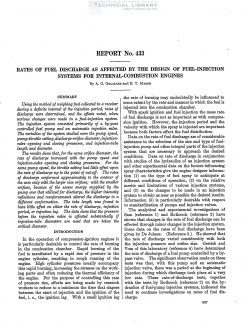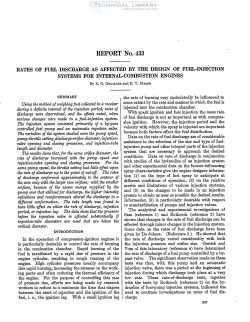naca-report-433

- Version
- 170 Downloads
- 1.43 MB File Size
- 1 File Count
- August 26, 2016 Create Date
- August 26, 2016 Last Updated
National Advisory Committee for Aeronautics, Report - Rates of Fuel Discharge as Affected by the Design of Fuel Injection Systems for Internal Combustion Engines

Using the method of weighing fuel collected in a receiver
during a definite interval of the injection period, rates of
discharge were determined, and the e ects noted, when
various changes were made in a fuel-injection system.
The injection system consisted primarily of a by—pass
controlled fuel pump and an automatic injection valve.
The variables of the system studied were the pump speed,
pump-throttle setting, discharge—orifice diameter, injection-
valve opening and closing pressures, and injection-tube
length and diameter.
The results show that, for the same orifice diameter, the
rate of discharge increased with the pump speed and
injection-valve opening and closing pressures. For the
same pump speed, the throttle setting‘had little eject upon
the rate of discharge up to the point of cut—01f. The rates
of discharge conformed approximately to the contour of
the cam only with the larger size orifices; with the smaller
orifices, because of the excess energy supplied by the
pump over that utilized for discharge, the higher intensity
reflections and reenforcements altered the discharge to a
difi'erent conformation. The tube length was found to
have little effect on either the rate of discharge, injection
period, or injection lag. The data show that the pressure
before the injection valve is afiected substantially if
injection—tube diameters are used that are below the
critical diameter.
In the operation of compression-ignition engines it
is particularly desirable to control the rate of burning
in the combustion chamber. Rapid burning of the
fuel is manifested by a rapid rise of pressure in the
engine cylinder, resulting in rough running of the
engine. High cylinder pressures usually accompany
this rapid burning, increasing the stresses on the work-
ing parts and often reducing the thermal efliciency of
the engine.
| File | Action |
|---|---|
| naca-report-433 Rates of Fuel Discharge as Affected by the Design of Fuel Injection Systems for Internal Combustion Engines.pdf | Download |

Comment On This Post